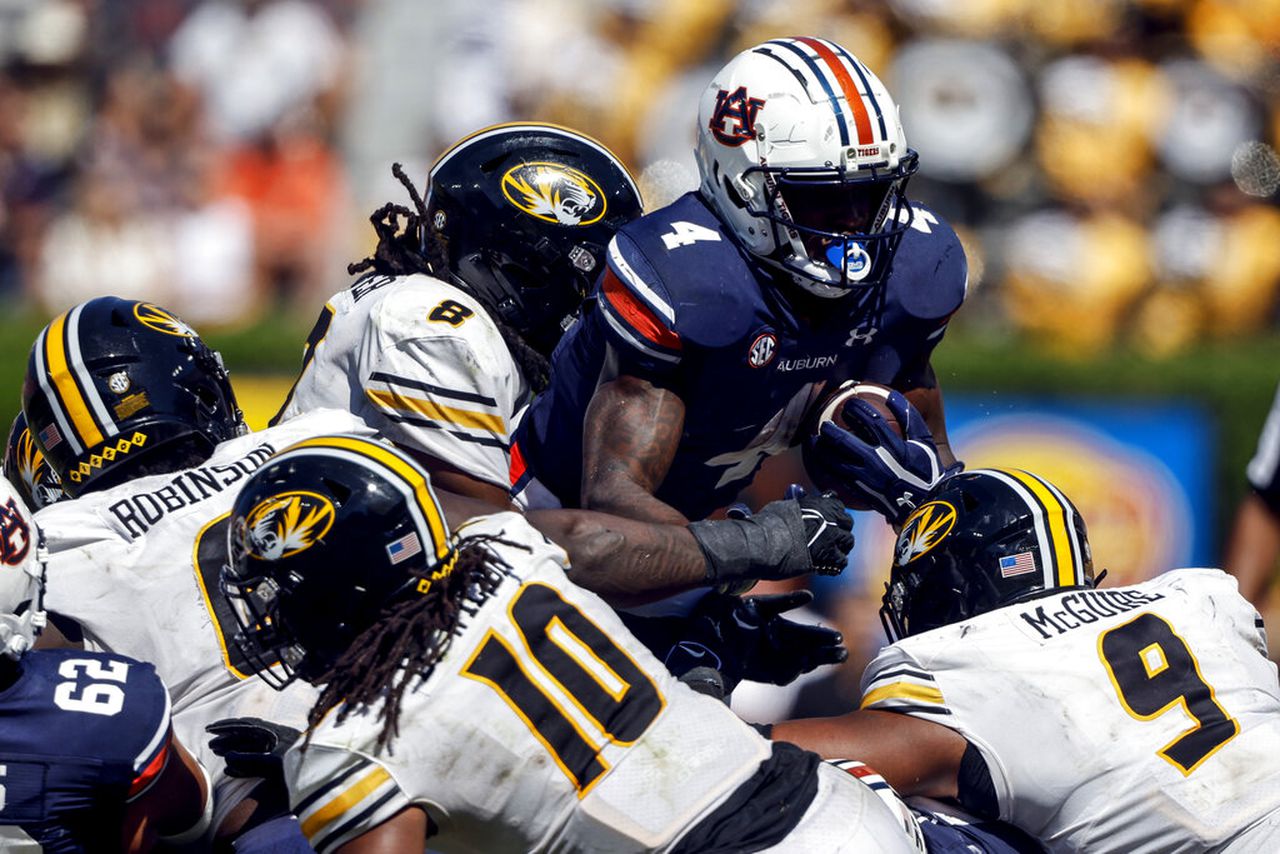Auburn’s poor run-blocking has Tank Bigsby mired in mediocrity
Auburn’s offense has a crack in its foundation.
The Tigers spent all offseason talking up the idea of building their offense around star running back Tank Bigsby, but the team has been unable to get its preseason first-team All-SEC back going through the first half of its schedule. The run game has struggled to find its footing, and Bigsby’s numbers have been mired in mediocrity six games into the season.
“That’s the key to what we have to do up front is just not give up penetration and get those backs a chance to get started,” Auburn coach Bryan Harsin said. “They’ll do something with it.”
Read more Auburn football: The pressing issue Auburn’s offense must resolve against Ole Miss
Goodman: Bryan Harsin proving Doug Barfield wasn’t so bad
Bryan Harsin left searching for answers, “hope” after blowout loss to Georgia
To this point, though, Bigsby hasn’t been able to do much with the ball in his hands.
The junior is 12th in the SEC in rushing this season, with 345 yards and four touchdowns, but he’s 15th in the conference in rushing yards per game (57.5). He ranks 111th nationally in yards per carry (4.37), but he’s averaging just 2.94 yards per carry in four games against Power 5 competition, which is 36th among SEC rushers this season and the worst among qualifying SEC running backs. The only SEC players with a worse rushing per-carry average against Power 5 teams this season are quarterbacks: Texas A&M’s Max Johnson, Missouri’s Brady Cook and South Carolina’s Spencer Rattler.
In those four games against quality competition — Penn State, Missouri, LSU and Georgia — Bigsby has averaged just 36.75 yards per contest. His numbers against Power 5 opponents have gone down in each season; he averaged 6.04 yards per carry and 83.4 yards per game in 2020 when he was the SEC Freshman of the Year, and last year those numbers dropped to 4.25 yards per carry and 78 yards per game against Power 5 opponents.
Bigsby has not had a 100-yard rushing performance since Auburn’s season-opener against Mercer, when he ran for 147 yards and two touchdowns on 16 carries. His last 100-yard game against an FBS opponent was last year’s loss at South Carolina, when he had 164 yards on 22 carries.
His 19 yards on 10 carries (1.9 yards per attempt) last weekend at Georgia marked his worst rushing performance since his college debut in 2020, when he ran for just 15 yards on six carries (2.5 yards per carry) in a win against Kentucky. Against the Bulldogs, four of Bigsby’s nine carries went for 1 yard, no gain or a loss of yards. A week earlier against LSU, when he ran for 45 yards on 12 carries, five of them gained 1 yard or fewer (two more carries picked up just 2 yards).
As Harsin aptly put it between those two games, it has been a lot of “feast or famine” for Auburn in the run game of late, and the substandard numbers don’t just fall on Bigsby’s shoulders; it’s about how the offensive line does in front of him, too. Too often, Bigsby faces first contact behind the line of scrimmage and has to shed defenders just to produce a short gain.
“Penetration slows the backs down,” Harsin said. “And depending on the run scheme — whatever it is, there’s different schemes — but you don’t want to give up penetration. That’s what’s happened to us at times. As far as adjusting, blocking is a fundamental of the game, probably the most important one. That goes back to footwork, that goes back to aiming points, it goes back to what the defense is trying to do to you, it goes back to how you prepare yourself each and every week — how we get our guys prepared.… You’ve got to be better up front; you don’t want to give up penetration.
“It’s not always that you’re moving and denting that defense all the time. But it gives your backs a chance when they can get to the line of scrimmage and be able to see and find a window. Sometimes it’s 2, 4 yards, but then you get some really good push, and it can be 8 or 18, it can be big runs.”
Those bigger runs have been harder to come by. In its four games against Power 5 opponents, Auburn has just three runs of at least 20 yards and no carries of 30-plus yards, though the Tigers do have 17 carries between 10 and 19 yards during that stretch. Bigsby has just three of those runs of 10-plus yards: a 12-yarder against Penn State, a 14-yarder against Missouri and a 23-yarder against LSU.
Overall, though, Auburn’s 4.1 yards per carry this season is 76th among FBS teams and on pace to be the program’s worst mark since the dreaded 2012 season (4.07 yards per carry). Any time you draw comparisons to that season, it’s suboptimal, but this year’s Auburn team seems to be doing so more and more this fall—and this time, it’s regarding an aspect that was supposed to be this offense’s strength, its foundation, in Year 2 under Harsin.
“Ultimately your game is going to come down to what the guys do up front — the fundamentals of how they play and block,” Harsin said. “…There were some good things that we did do. Now we have got to get all 11 guys doing that together. I think that is the key moving forward, really focusing on that, but our guys work very hard at it. They will get better at it. We are not where we are where we need to be. We have got to go back to work this week to improve in those areas.”
Tom Green is an Auburn beat reporter for Alabama Media Group. Follow him on Twitter @Tomas_Verde.
